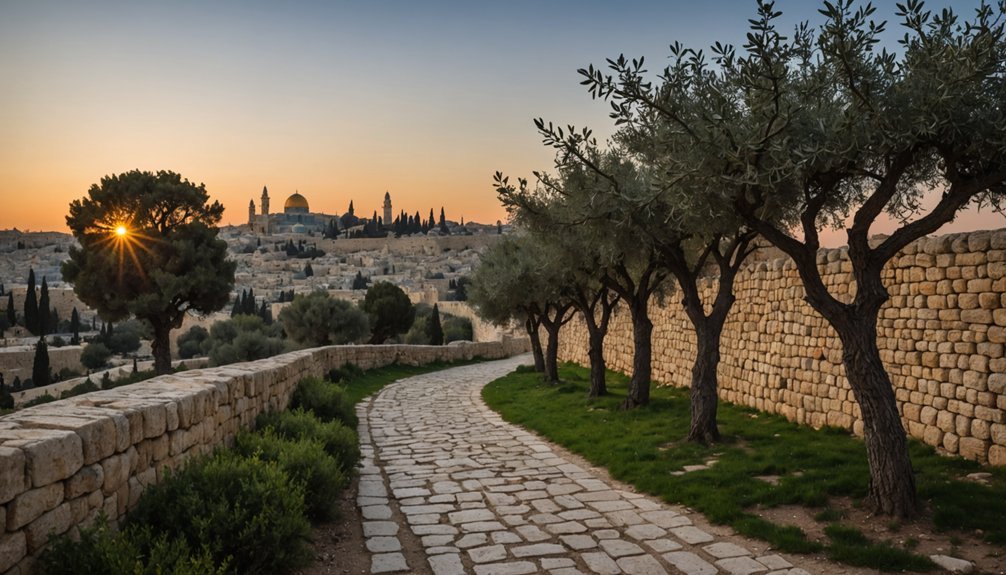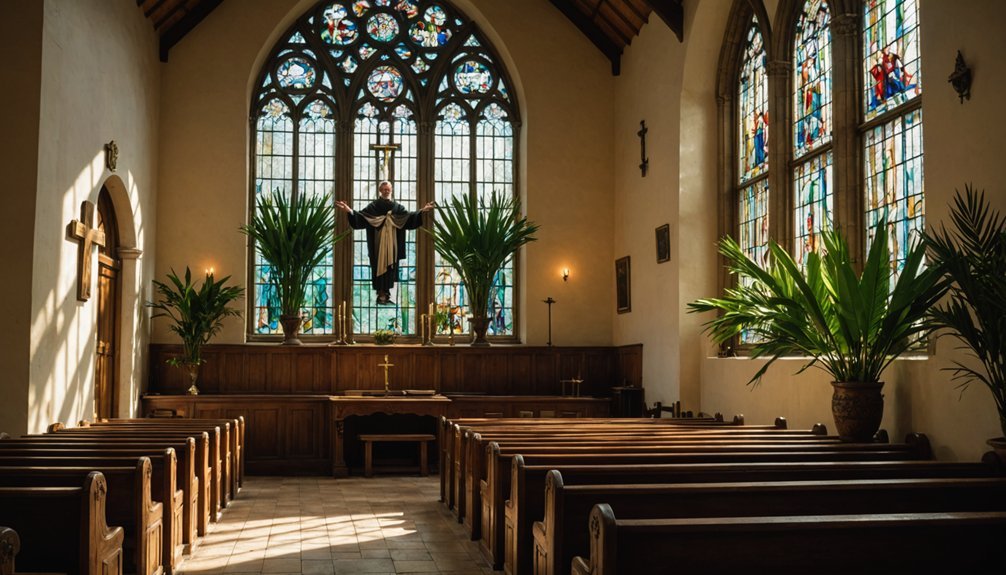As you reflect on Palm Sunday, consider the profound messages in Matthew 21:1-11 and John 12:12-19. These scriptures don't just recount Jesus' humble entry into Jerusalem; they invite you to explore the depths of redemption and the echoes of prophecy fulfilled. Imagine the crowds, their palms waving, shouting "Hosanna!"—a plea for salvation. What does this scene reveal about your own spiritual journey? Think about how these moments of celebration intertwine with the anticipations of Holy Week.
Key Takeaways
- Read Zechariah 9:9 to understand the prophecy of a peaceful king Jesus fulfilled by riding a donkey.
- Explore Matthew 21:9 and Psalm 118:25-26 for insights into the crowd's cries of "Hosanna" and their significance.
- Study John 12:12-19 to grasp the crowd's recognition of Jesus as the Messiah during His triumphal entry.
- Reflect on Luke 19:41-44 to comprehend Jesus' lament over Jerusalem and His call for a deeper relationship with God.
- Consider the role of palm branches in John 12:13 as symbols of victory and celebration, representing redemption.
The Triumphal Entry: Understanding Matthew 21:1-11
As you explore Matthew 21:1-11, you'll find Jesus orchestrating a pivotal moment that fulfills ancient prophecy. During this triumphal entry into Jerusalem, the scene is rich with symbolism and anticipation. Crowds lay palm branches before Him, a gesture of honor and recognition of His kingship. Their shouts of "Hosanna to the Son of David" not only hail Him as King but also echo a deep longing for deliverance. Unlike earthly kings, Jesus enters the city in peace, mounted humbly on a donkey, diverging sharply from military expectations. This profound act not only marks Palm Sunday but sets the tone for His peaceful approach, aligning perfectly with the prophetic vision of a gentle ruler.
Prophecies Fulfilled: Exploring Zechariah 9:9 and Matthew 21:5

While exploring the profound connection between Zechariah 9:9 and Matthew 21:5, you'll discover how precisely Jesus' triumphal entry into Jerusalem fulfills ancient prophecy. Zechariah foreshadows a king, humble and riding on a donkey, symbolizing not war but peace. This imagery isn't just poetic; it's a direct prophecy about Jesus, who enters Jerusalem not on a warhorse, but a donkey, aligning perfectly with these prophetic words.
This moment isn't merely historical; it's the fulfillment of a divine promise. Matthew 21:5 doesn't just recount this event; it ties back to Zechariah, emphasizing Jesus as the king who comes to save. This act, witnessed by the crowds waving palm branches, cements Jesus' role as the awaited Messiah, the king of peace and salvation.
Celebrating the King: Insights From John 12:13 and Luke 19:38

Every Palm Sunday, believers around the world recall how the crowd greeted Jesus with palm branches and shouts of "Hosanna!" in John 12:13, clearly recognizing Him as the Messiah. This moment, steeped in Jewish tradition, symbolizes triumph, as the palm branches they waved are tokens of victory. In Luke 19:38, the scene deepens with voices blessing Jesus as the king who comes in the name of the Lord. This isn't just any king; you're welcoming the bringer of peace and divine authority. As you reflect on these passages during Holy Week, you're not merely remembering historical events; you're celebrating the fulfillment of prophecy and the transformative arrival of your Savior, marking the commencement of a journey toward ultimate redemption.
The Crowd's Response: Reflecting on Matthew 21:9 and John 12:12-19

Reflect now on the vivid scenes depicted in Matthew 21:9 and John 12:12-19, where the crowd's overwhelming joy and spiritual recognition of Jesus as Messiah come to life. As Jesus entered Jerusalem, the whole city was stirred by the crowd's response. You can almost hear their united voices shouting, "Hosanna to the Son of David! Blessed is He who comes in the name of the Lord!" This wasn't just a cheer; it was a plea—"Hosanna" means "save us." They saw Him as the Son of David, a king who'd bring peace from heaven. Their actions—waving palm branches and spreading cloaks—weren't just welcoming gestures; they were acts of homage to the prophesied king.
Jesus' Lament Over Jerusalem: A Study of Luke 19:41-44

As Jesus approached Jerusalem, He wept openly over the city, a profound scene captured in Luke 19:41-44. His tears reflected deep compassion for the people who'd miss the chance to embrace salvation. Jesus' lament over Jerusalem underscores the tragic rejection of the peace He offered. You see, as He looked upon the city, He foresaw the dire consequences of this dismissal—enemies encircling, the city's downfall, and suffering for its children. Jesus longed for Jerusalem to recognize Him as the bringer of redemption. This passage poignantly reminds you of the importance of seizing opportunities for peace and reconciliation, and the profound loss when God's presence is overlooked in your life.
The Role of Palm Branches: Symbolism in John 12:13

As you explore John 12:13, notice how the palm branches aren't just decor; they're potent symbols of victory and triumph. This gesture roots in Jewish tradition, marking Jesus' celebratory welcome into Jerusalem as something deeply significant—both a fulfillment of custom and a vibrant expression of the people's hope and reverence. By waving these branches, the crowd wasn't just greeting Jesus; they were anointing Him as their hoped-for deliverer from oppression.
Victory and Triumph
When the crowd in John 12:13 greeted Jesus with palm branches, they weren't just celebrating His arrival; they were symbolically declaring Him victorious and triumphant. By waving these branches, traditionally associated with victory and triumph, they acknowledged Jesus as their King during His humble entry into Jerusalem. This act set a tone of redemption that threaded throughout Holy Week. The palms not only marked a joyful reception but also contrasted sharply with the expectations of a conquering warrior. Instead, they highlighted Jesus' peaceful and humble approach as He rode on a donkey, fulfilling messianic prophecies and redefining what it meant to be a king in the eyes of His followers.
Jewish Symbolic Gesture
Continuing from the theme of victory and triumph, let's explore the deeper significance of the palm branches in John 12:13.
- Symbol of Victory and Peace: The palm branches you're waving echo ancient Jewish customs, where they represented victory and salvation. This gesture marks Jesus as the deliverer, the one who brings peace.
- Shouts of "Hosanna": When you cry "Hosanna," you're not just cheering; you're pleading for salvation. This reflects your hope in Jesus as the Messiah, the divine deliverer.
- Royal Reception: Laying these branches before Jesus isn't just decor; it's your way of giving Him a royal reception, acknowledging Him as King.
- Community's Recognition: This act unites you and your community in recognizing Jesus' authority and your collective yearning for divine deliverance.
Celebratory Welcome Act
You'll notice that in John 12:13, the crowd's act of waving palm branches as Jesus enters Jerusalem isn't just a festive gesture; it's steeped in rich symbolism. As Jesus rode a donkey into the Holy City on that Sunday, the palm branches in their hands weren't mere decorations. They were symbols of triumph, historically linked to Jewish festivals and celebrations. The crowds answered Jesus' humble arrival with "Hosanna," a cry for salvation, acknowledging Him as the Messiah who comes to offer redemption. This celebratory welcome act not only accepted His kingship but also foreshadowed the sorrow yet to come, blending deep joy with the gravity of the week that would define Christianity forever.
How Can Key Scriptures on Palm Sunday Help Us Reflect on the Events of the Palm Sunday Massacre?
Key scriptures observed on Palm Sunday provide a profound context for reflecting on the palm sunday tragedy. By examining the themes of triumph and betrayal within the biblical narratives, we can gain insight into the complexities of faith and humanity, allowing us to draw parallels with the sorrowful events of our time.
Hosanna in the Highest: The Significance of Matthew 21:9 and Psalms 118:25-26

As you explore the events of Palm Sunday, consider how Matthew 21:9 and Psalms 118:25-26 highlight the crowd's joyous celebration of Jesus' arrival. The phrase "Hosanna" isn't just a cheer; it's a heartfelt plea for salvation, deeply rooted in the desire for deliverance that Jesus embodied. These scriptures not only recognize Jesus as the Messiah but also set the stage for the themes of peace and salvation that unfold during Holy Week.
Celebrating Jesus' Arrival
While celebrating Palm Sunday, imagine the vibrant scene as crowds gather, waving palm branches and exclaiming "Hosanna to the Son of David" in a powerful display of recognition and praise. Here's why this moment is pivotal:
- Recognition of Messiah: The crowd's use of "Hosanna" acknowledges Jesus not just as a teacher, but as the prophesied King, fulfilling Old scriptures predictions.
- Plea for Salvation: By shouting "Hosanna," they express their hope in Jesus' power to bring redemption and salvation.
- Celebration of Kingship: The entry into Jerusalem symbolizes Jesus' acceptance of His kingly role, steering the narrative of divine authority.
- Prophetic Alignment: This event aligns with Psalm 118's themes of deliverance, marking a significant moment of spiritual and historical revelation.
Understanding "Hosanna" Praise
Reflect on the scene of Palm Sunday and you might find yourself moved by the shouts of "Hosanna" that filled the air as Jesus entered Jerusalem. This ancient cry for "save us now" highlighted the crowd's recognition of Jesus Christ as the Messiah. By calling Him "Hosanna to the Son of David," they acknowledged His royal lineage and their hope for redemption. The palm branches they waved symbolized victory, making their praises not just a personal plea, but a public declaration that Jesus was the King who could change the world. Through these actions and words, rooted deeply in Psalm 118:25-26, the Holy moment of Jesus' entry became a profound fulfillment of prophecy, merging divine promise with earthly celebration.
Themes of Salvation
If you explore the themes of salvation in Matthew 21:9 and Psalms 118:25-26, you'll notice a powerful connection that highlights the significance of the term "Hosanna." This expression, meaning "save us now," was shouted by the crowds as Jesus made His triumphant entry into Jerusalem.
- Recognition of Jesus as Messiah: The cry "Hosanna to the Son of David" acknowledges Jesus as the king who comes in God's name, fulfilling Old scriptures.
- Plea for Deliverance: Hosanna expresses an urgent plea for salvation and the forgiveness of your sins.
- Celebration of Divine Intervention: It marks Jesus' role in God's plan for redemption.
- Establishing a Relationship with God: Passion Sunday emphasizes reconnecting with God through Jesus' sacrifice and love.
Frequently Asked Questions
What Is a Good Scripture to Read for Palm Sunday?
You're looking for a fitting scripture to read on Palm Sunday? Try Matthew 21:9. This passage vividly captures the crowd's adoration as they greet Jesus with shouts of "Hosanna to the Son of David!" It highlights the recognition of Jesus as the Messiah, which sets the tone for the day's celebration. This scripture not only reflects the historical event but also deepens your understanding of its significance.
What Do You Reflect on Palm Sunday?
On Palm Sunday, you reflect on Jesus' triumphant entry into Jerusalem, an event that sets the stage for the unfolding of Holy Week. You might consider the crowd's cheers of "Hosanna," symbolizing both their temporary joy and the deeper, more complex journey of Jesus towards the cross. This day challenges you to balance the celebration of Jesus' kingship with the somber anticipation of His sacrifice for humanity's redemption.
What Verse in the Bible Talks About Redemption?
You're looking for a Bible verse about redemption? John 3:16 is a go-to, declaring that God gave His only Son so everyone who believes in Him won't perish but have eternal life. This verse captures the essence of redemption—God's sacrifice allows for your salvation. Similarly, Romans 3:23-24 tells us all have sinned but are justified freely by His grace through the redemption that came by Christ Jesus.
What Are the Key Points of Palm Sunday?
On Palm Sunday, you celebrate Jesus' triumphant entry into Jerusalem, marking the start of Holy Week. Crowds greeted Him with palm branches, shouting "Hosanna," recognizing Him as the prophesied king. This day merges joy with the somber anticipation of Jesus' sacrifice. It's a day for you to reflect deeply on welcoming Jesus into your life, symbolized by the traditional procession of palms, echoing the crowd's ancient praise and reverence.
Conclusion
As you reflect on Palm Sunday, remember the profound messages in these scriptures. They not only recount Jesus' humble entry but also invite you to recognize His call for salvation and kingship. Embrace the hope and redemption signaled by the crowd's cries of "Hosanna!" Let this Holy Week deepen your relationship with God, understanding His love and sacrifice more fully. Celebrate the fulfilled prophecies and the promise of deliverance that Palm Sunday heralds.

